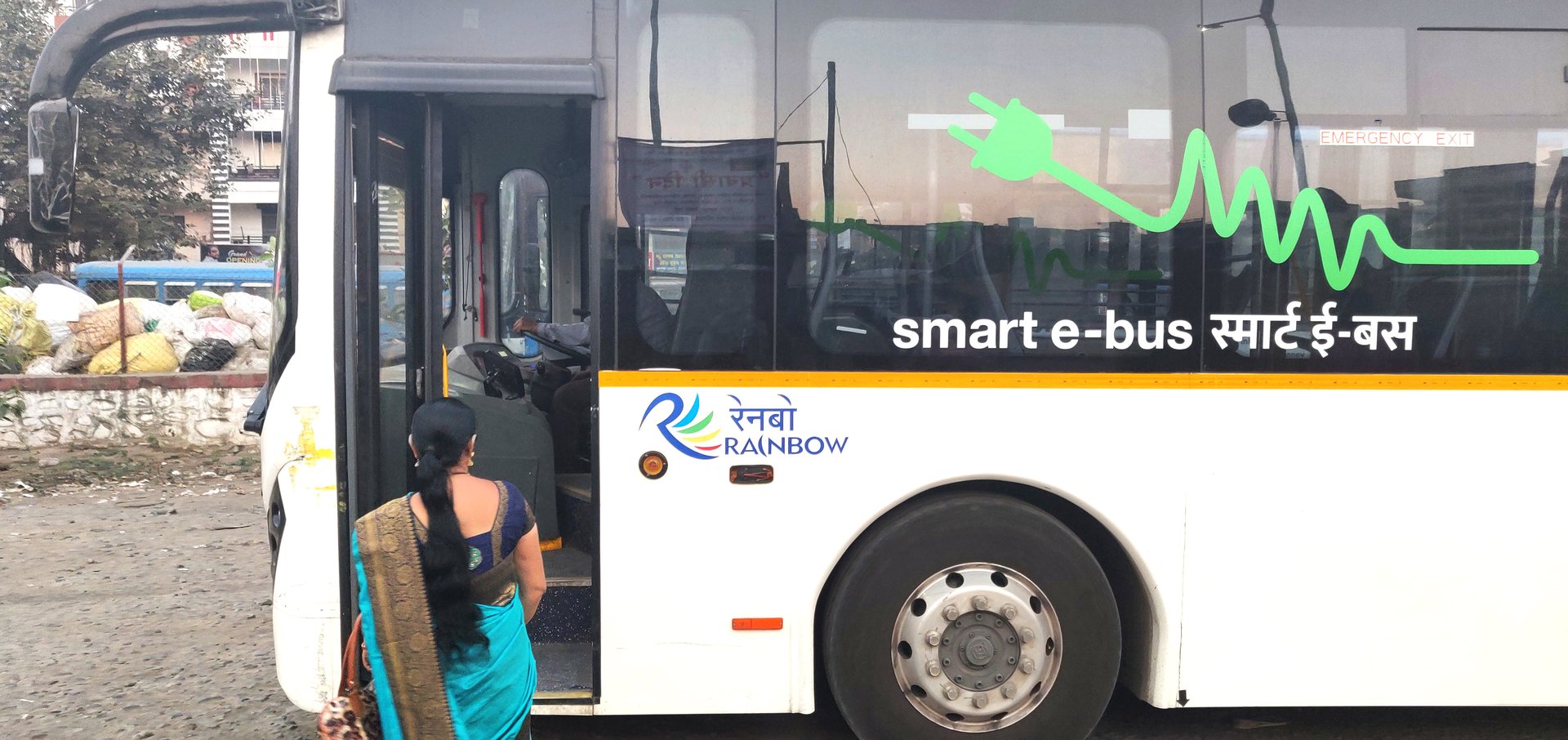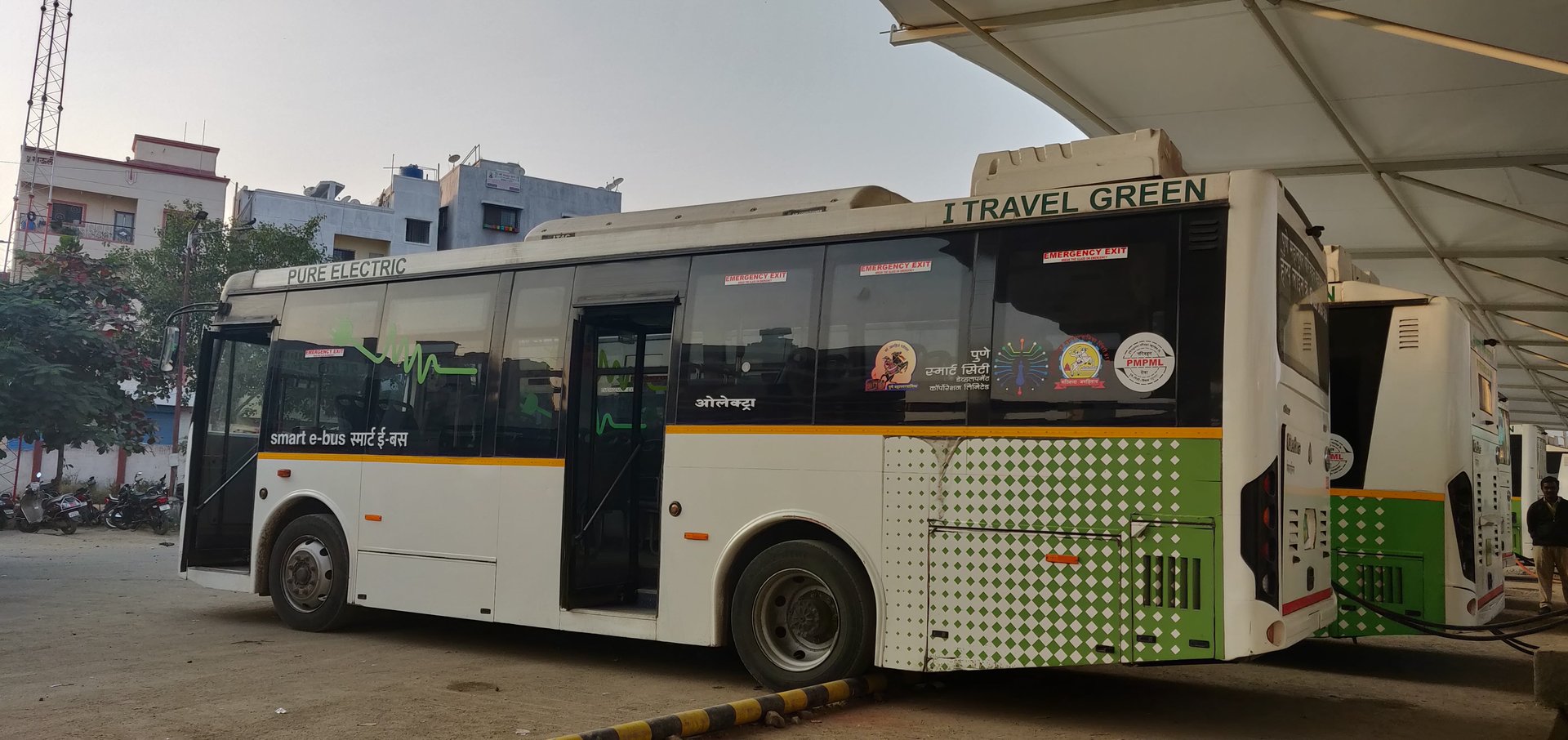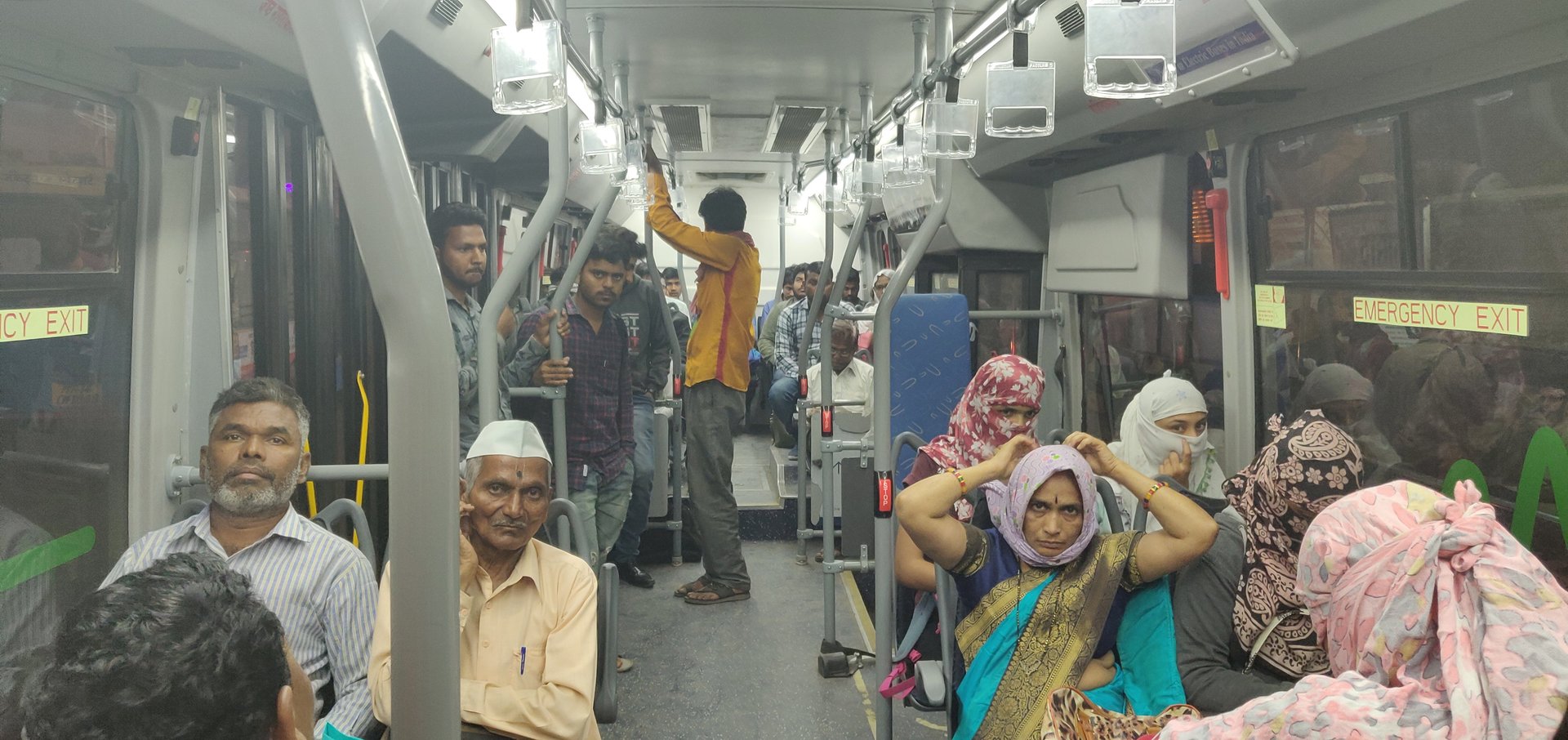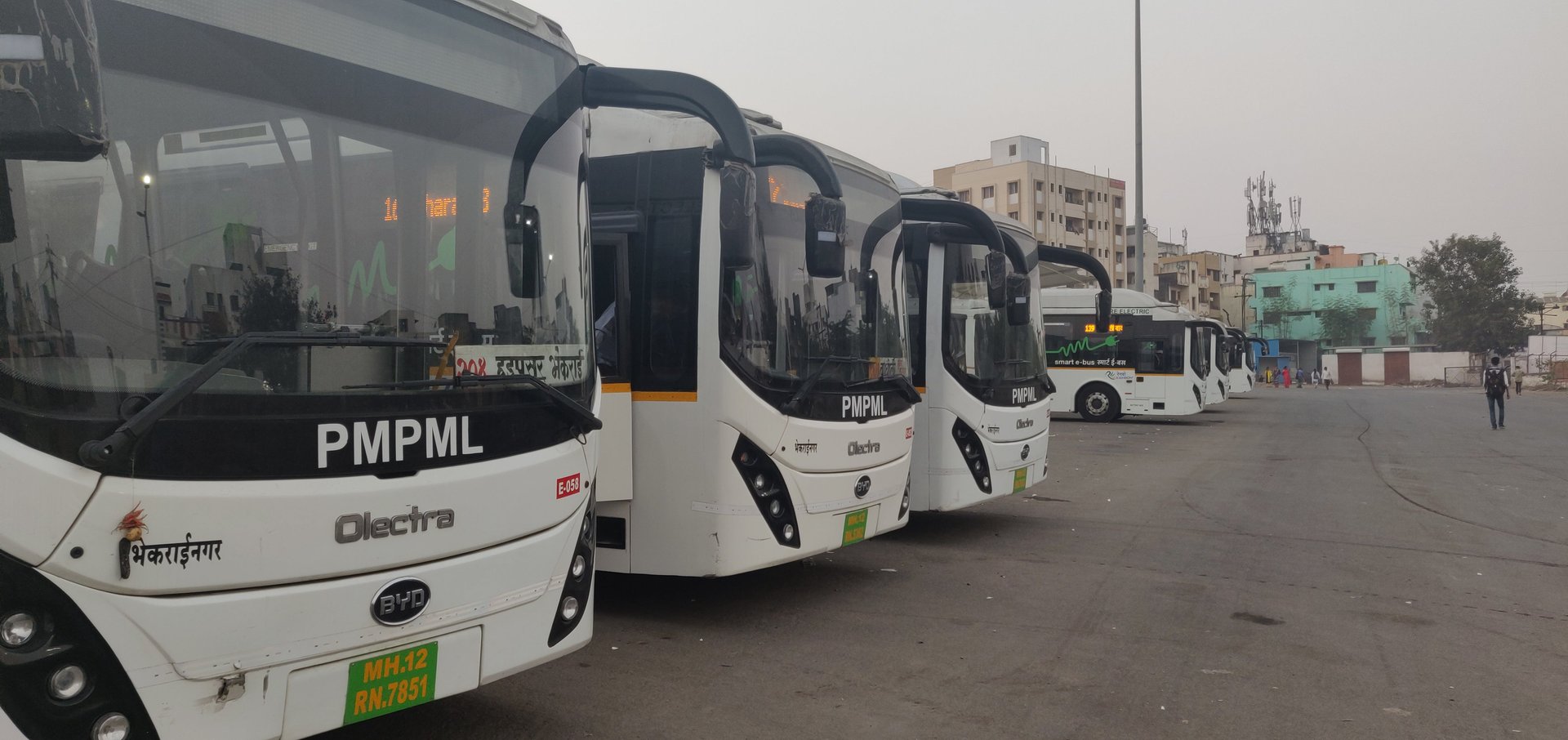Can electric buses solve India’s transit crisis? This city may hold the answer
A row of electric buses stand parked at the Bhekrai Nagar bus depot in the western Indian city of Pune, just as the late November sun is about to set. Some of them are plugged into charging stations, topping up their batteries, while others wait to start their next trip. At the bus shelter outside, a group of passengers wait to board one of the 90 electric buses (e-buses) that the depot services.


A row of electric buses stand parked at the Bhekrai Nagar bus depot in the western Indian city of Pune, just as the late November sun is about to set. Some of them are plugged into charging stations, topping up their batteries, while others wait to start their next trip. At the bus shelter outside, a group of passengers wait to board one of the 90 electric buses (e-buses) that the depot services.
The scene is quotidian, but beneath the surface lies a unique experiment in running an environmentally sustainable city transit system.
In January 2019, Pune became the first Indian city to adopt e-buses and Bhekrai Nagar the country’s first all-electric bus depot. As of November 2019, up to 133 electric vehicles (EVs) have been deployed across the city in the first phase of its e-bus programme.
The city’s transit authority, Pune Mahanagar Parivahan Mahamandal (PMPML), however, has not purchased any of the e-buses; they are owned, operated, and maintained by their manufacturer, the Secunderabad-based Olectra Greentech and its Chinese technical partner BYD. PMPML’s role includes scheduling and testing the buses for their range, power consumption, and charging times.
The PMPML-Olectra partnership in Pune offers a blueprint that might rejuvenate urban mobility across the country.
Green comfort
In the past year, Olectra’s air-conditioned e-buses have emerged as the preferred option for Pune’s commuters. “People wait for e-buses now, especially in the hot summer months. They don’t like to get onto non-air conditioned CNG or diesel buses,” Praneet Baiju, coordinator of Olectra’s electric bus programme in the city, told Quartz when we visited the depot last November.
“The older (diesel- or CNG-based) buses were noisy and dusty and I would often feel nauseous in them,” said Kirti Chaudhary, a 30-year-old Bhekrai Nagar local who travels by bus every day to her computer classes nearby. “The electric buses are pollution-free, air-conditioned, and much smoother.”
Olectra’s buses have been deployed on only 15 routes in the city so far, but Chaudhary is happy with their frequency on the routes that they do ply on.
“There are multiple e-buses on a single route,” she said. “Earlier, I’d end up waiting for 30-60 minutes at the bus stop, but with these buses, I don’t think I’ve ever waited for more than 15 minutes.”

The noiseless vehicles provide convenience and comfort—USB charging ports, automated doors that open at the push of a button, and a designated space for wheelchairs—at the same base charge (Rs10 or $0.14) as a conventional bus.

Globally, it is well established that e-buses are the way forward for mass transit. They exist at the confluence of public transport and electric mobility, both of which lower air pollution and carbon dioxide (CO2) emissions.
Under the Narendra Modi administration’s flagship e-mobility programme, FAME II, plans are afoot to deploy 5,095 e-buses across Indian cities with state transit authorities partnering manufacturers like Olectra.
“Over their lifetime, these (FAME II) buses will run 3 billion kilometres without tailpipe emissions, save 77 lakh barrels worth of oil and 6 lakh tonnes of carbon dioxide emissions,” said Clay Stranger, a senior director at Rocky Mountain Institute, who leads the urban mobility programme in India for the institute and has also played a key role in drawing up urban mobility solutions for Pune.
In spite of these benefits, India’s public transit authorities have been reluctant to induct them into their fleets. Their higher costs make them prohibitive for city transit authorities reeling under financial duress. While a standard 12-metre Olectra-BYD e-bus costs Rs2 crore, a similar CNG bus is priced at just Rs48 lakh, and a diesel one even less, Nayana Gunde, managing director of PMPML told Quartz.
However, e-buses do have an economic advantage over conventional buses—they are cheaper to operate and maintain. It is this attribute that PMPML leverages in its partnership with Olectra.
Pay as you go
In Pune, PMPML is paying Olectra to operate its e-buses on a per-kilometre basis rather than spending money it doesn’t have on buying the buses from the manufacturer.
Olectra is then responsible for running all operations, maintaining the bus, recruiting and training drivers, and ensuring that all personnel at the depot know their way around a charging station.
“We went through a 15-day training period before we could start driving in the city,” said Sunil Waghmare, one of the drivers trained by Olectra for Pune’s e-bus programme. “An electric bus is longer than a regular (diesel or CNG) bus and it took some time to get used to it.”
For Olectra, the goal is to accumulate enough “electric kilometres” to turn a profit. “We expect to break even on our buses when they each complete 300,000 km, which will take 4.5 years on average,” said Naga Satyam, executive director of Olectra.
PMPML takes over scheduling, deploys a conductor on each bus, and collects the ticket fare from passengers, which is its primary source of revenue. Transferring the hefty costs of hiring drivers and maintaining city buses to manufacturers like Olectra makes e-buses cheaper to run on a per-kilometre basis than a fuel engine bus.
“PMPML spends Rs90 per kilometre to maintain a (diesel or CNG) bus, but under this financial model, the cost of running an e-bus is Rs68 per kilometre for a small bus and Rs74 per kilometre for a larger one,” said Gunde.
So significant is this advantage that it presents a unique opportunity to gradually replace conventional buses with e-buses in India’s ageing public bus fleets. This can in turn address the country’s transit crisis.
A commuter’s life
Across urban India, commuters struggle to find ways to move around cheaply and conveniently.
In most big cities, mass transit options are either limited or running on inadequate infrastructure, leaving city professionals to resort to two- and three-wheeled vehicles, or their own personal cars, to move around, choking the streets in the process. Bengaluru, India’s biggest software hub, for instance, has the world’s worst road traffic.
The shortage of buses is particularly acute. “Relative to demand at a national level, there is quite a large deficit of buses (in India),” said Stranger. “If you take Delhi, I think there are 5,500 buses operating, whereas the demand is more than double that number.”
Even in Pune, deemed the most liveable city in the country, the fleet of 2,000 buses falls far short of the 3,500 buses required to serve the city’s seven million residents, according to Gunde.
It then becomes imperative to address urban mobility woes through mass transit systems. Here e-buses become a critical link.
“As we look at (achieving) zero-emission mobility, we don’t really prioritise the number of electric vehicles on the roads or electric vehicle kilometres. Our priority is electric passenger kilometres (the distance travelled by users/passengers in electric vehicles). And there’s no better way to deliver electric passenger kilometres in bulk than by using electric buses,” said Stranger.
PMPML aims to deploy 650 e-buses across three phases. The first two phases of 150 and 350 buses, respectively, will be subsidised by the state government and the centre’s Smart Cities Mission. The third phase will fall under the national FAME II scheme.
However, if more e-buses are to be inducted into India’s public transit systems, cities will have to take a trip down a necessarily rocky road.
The tough road ahead
Commuters’ preference for air-conditioned comfort often places e-buses at the risk of being overloaded, which means a bus consumes more energy and their batteries discharge faster.

An electric bus generally takes around four hours to charge close to full capacity. As the number of electric buses grows, cities will need space and infrastructure for additional charging stations. Pune currently has only two depots for its 133 e-buses and to expand its electric fleet, more depots will have to be dedicated to e-buses, said Baiju.
India’s financially embattled power sector does not inspire confidence either. Due to power fluctuations and related issues, only 39 of the 56 charging stations at the Bhekrai Nagar depot were operational when we visited the site. While that suffices for now, scaling up to other parts Pune will require reliable power sources to schedule and run an e-bus fleet seamlessly.
Moreover, while it has been established that EVs are more climate-friendly than their fossil fuel counterparts even when charged with coal-based power, expanding e-bus fleets in cities will need to be accompanied with greater sources of renewable energy.
The government also needs to work on raising the number of electric bus manufacturers for meaningful competition in the industry, says Deepak Rajagopal, an associate professor at the University of California Los Angeles’ Institute of Environment and Sustainability. India’s e-bus marketplace currently has only a few major manufacturers such as Tata Motors, and Ashok Leyland, besides Olectra.
Additionally, “traffic jams increase our cost of operations. If there is a lot of traffic, sometimes we won’t be able to complete the trip, and will be penalised for it,” added Olectra’s Satyam.
The electric buses that are joining the fleets of Indian cities are transit authorities’ first serious experiment with the technology. How they perform will be instrumental in how Indian cities think about electric buses in the years to come.
The road to electrifying India’s city bus fleets is a long one, filled with potential landmines. The efforts, however, must persist.
“It is imperative that India persist with the experiment because electric buses in my mind are not really a top-down policy decision,” said Stranger. “They are an outcome of both technological and economic forces that are at work globally. It’s less about whether they are a preference and more about a premier technology that is emerging.”